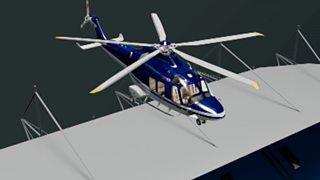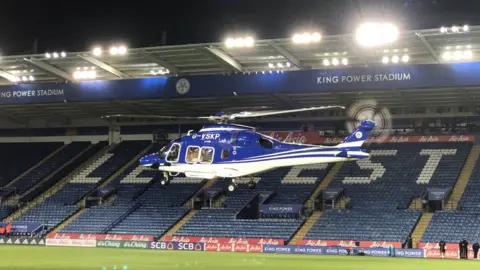
Leicester City helicopter crash: Pilot could have done ‘very little’
The pilot of the helicopter that crashed outside Leicester City’s stadium said “I’ve no idea what’s going on” as it spun out of control, killing five people including its chairman.
Eric Swaffer, 53, made the comment before the aircraft crashed outside the King Power Stadium on 27 October 2018.
The final report into the crash concluded he could have done “very little” to save those on board.
A lawyer for three of the victims said it “was an accident waiting to happen”.
The crash claimed the lives of Leicester City chairman, Vichai Srivaddhanaprabha, two members of his staff – Nusara
Suknamai and Kaveporn Punpare – and pilots and partners Mr Swaffer and Izabela Roza Lechowicz.
The Air Accidents Investigation Branch (AAIB)’s final report said a tail rotor bearing seized, which in turn caused the crash.
The AAIB said the crash was “inevitable” after a sequence of mechanical failures.
Chief inspector of air accidents at the AAIB, Crispin Orr, said Mr Swaffer did what he could to control the Leonardo
AW169 helicopter, but the catastrophic failure in a bearing in the tail rotor resulted in the aircraft making a sharp
right turn.
As the helicopter – which had reached an altitude of about 430ft (131m) – was turning out of control, a shout of “hey,
hey, hey” came from the rear cabin, where Mr Vichai and his employees were seated, the AAIB said.
In aircraft voice recordings, Mr Swaffer was heard to say: “I’ve no idea what’s going on”, shortly before the helicopter
crashed into a concrete step.
Inspectors said four of the passengers survived the impact of the crash, but a fire that was caused by a “significant”
fuel leak, proved fatal.

Four first responders were treated for heat-related ailments after trying to save the passengers on the plane.
According to the report, two police officers who arrived at the scene a minute after the event tried, but failed, to use
their batons to break the helicopter’s windscreen.
“This was a tragic accident in which five people tragically lost their lives,” said Mr. Orr. Their loved ones and
everyone affected are in our thoughts.
After what the AAIB previously referred to as a “technically very complex” examination, the final report, which is
209 pages long, took nearly five years to complete.
Because of the locations of some important components’ manufacturing, authorities from the US, Canada, France,
and Italy were also involved in the inquiry.
After the helicopter lifted off, the inquiry found that a worn bearing on the tail rotor had seized.
The helicopter then spun out of the pilot’s control as a result of the shaft controlling the tail rotor unscrewing and
becoming detached.
The helicopter met “all applicable airworthiness requirements” and had been properly maintained before to the
disaster, according to the AAIB assessment.

Additionally, the inspectors discovered that the rotor bearing wear was unpredictably excessive and had accumulated
over time.
The helicopter had only been in flight for 331 hours when the crash happened, and the bearing only needed to be
examined after 400 hours of use.
The AAIB cited the lack of maintenance tests to compare the state of used bearings to their original design as one of
the “contributory factors” in the regulations.
Pilot mistake and drone participation were excluded.

Following its examination, the AAIB has recommended eight safety measures to “address weaknesses or omissions”
in the rules governing the certification of large helicopters to the European Aviation Safety Agency (EASA).
The collision happened a little more than an hour after Leicester City vs. West Ham United in the Premier League.
Read more news on https://sportupdates.co.uk/

Leave a Reply